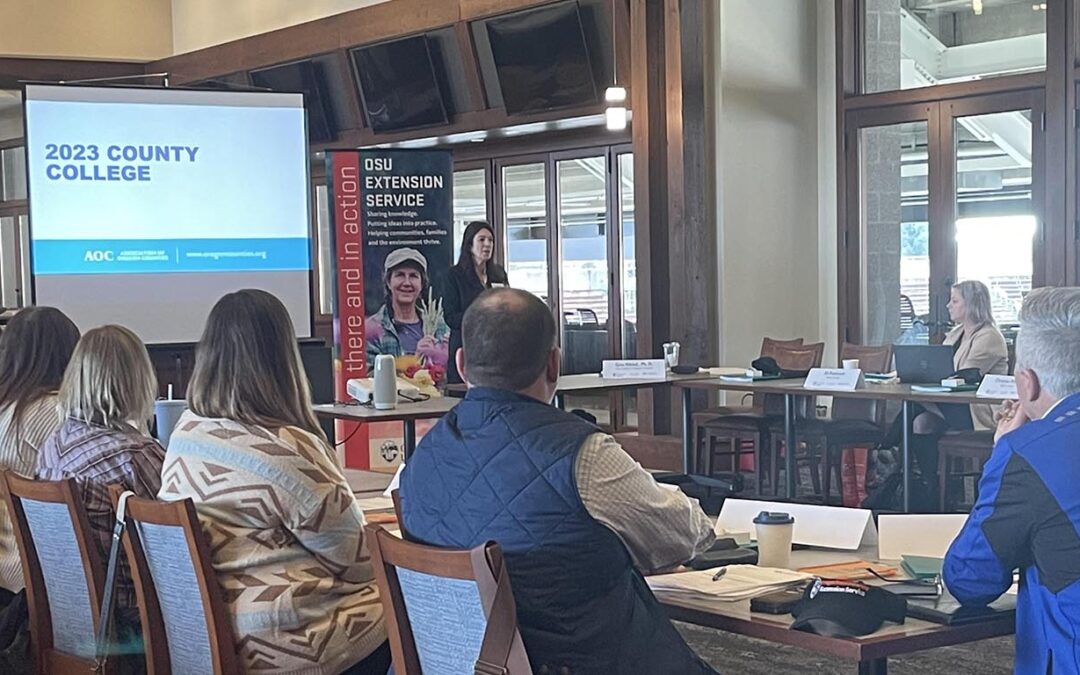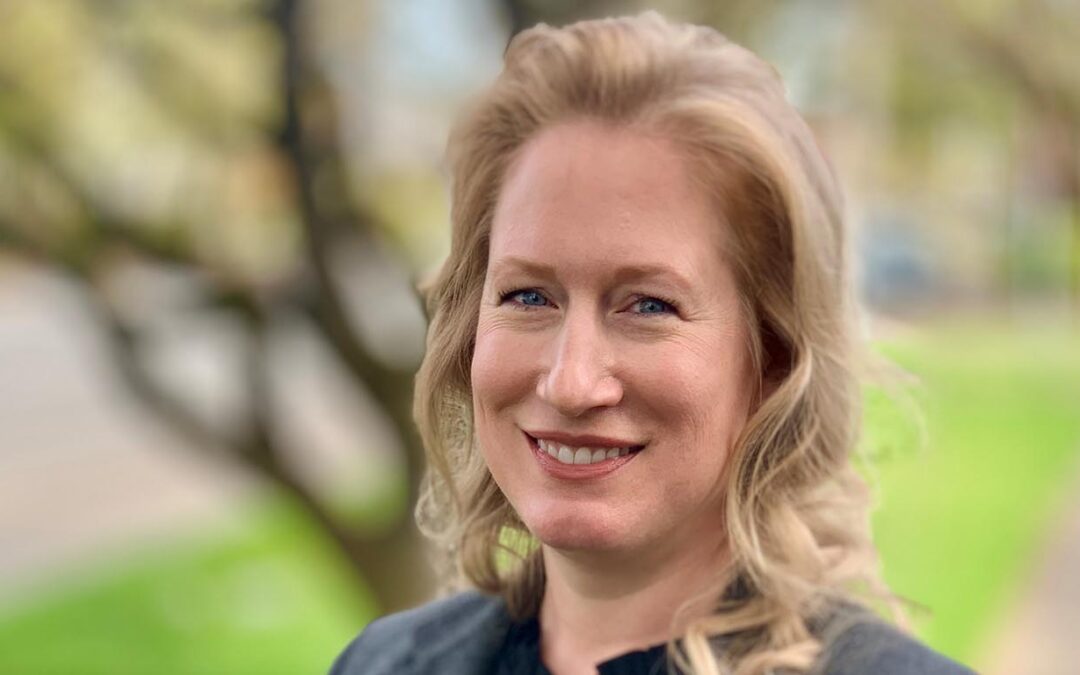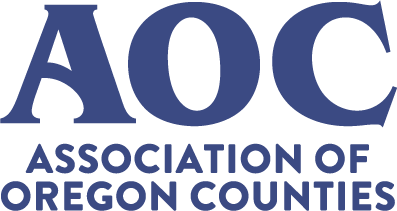
Feb 24, 2023 | AOC News
The March Economic and Revenue Forecast was presented during a joint meeting of the Senate Committee on Finance and Revenue and the House Committee on Revenue and House Revenue Committees on Feb. 22. The committees heard from state economists at the Office of Economic Analysis that there will be “additional resources available for policymakers” as they develop the 23-25 biennium budget. Compared to the December Economic and Revenue Forecast the projected ending balance is up $487.1 million. That said, analysts also noted there is still an amount of uncertainty, including a full tax cycle broaching in April and noted the office will be in a better position in the middle of May when they present the close-of-session forecast to understand actual receipts and available funds. The May Economic and Revenue Forecast will be used by lawmakers to develop the 23-25 biennial budget. The latest projections could help eliminate the projected $560 million shortfall predicted by analysts in December.
Corporate and personal income taxes remain strong, showing 25 percent annual growth over the past five years, far more rapid than underlying measures of profits would suggest. Analysts commented that with the improved baseline economic outlook, additional gains in most taxes are expected through the 23-25 biennium, with a notable exception in the marijuana tax, which is expected to fall by 11 percent due to low prices, reducing drug treatment funds.
New Facts
- Fourth quarter personal income tax collections came in $261.6 million (9.4 percent) above the December 2022 forecast.
- Fourth quarter corporate income tax collections came in $131.1 million (54.6 percent) above the December 2022 forecast.
- Fourth quarter state personal income was $1.1 billion (-0.4 percent) below the December 2022 forecast.
- Fourth quarter state employment was 6,655 jobs (0.3 percent) above the December 2022 forecast.
Change Since Close of Session
- Personal income tax revenue is up $3,557.4 million (17.2 percent) from the 2021 close-of-session estimate.
- Corporate tax revenue is up $1,545.5 million (115.0 percent) from the 2021 close-of-session estimate.
- General Fund gross revenue is up $5,483.6 million (23.4 percent) from the 2021 close-of-session estimate.
- Net General Fund and Lottery fund resources are up $6,653.6 million (24 percent) from the 2021 close-of-session estimate.
Kicker Funds Implied by Forecast
- Personal – A personal kicker of $3,938.2 million is projected for 2023.
- Corporate – A corporate tax revenue of $1,545.5 million is projected to be dedicated to K-12 education spending in the 23-25 biennium.
Revenue Changes
- Projected 21-23 biennium net General Fund resources are up $487.1 million (1.7 percent) from the December 2022 forecast.
- Projected 2021-23 Lottery Fund resources are up $16.4 million (0.9 percent) from the December 2022 forecast.
- Projected combined net General Fund and Lottery Fund resources are up $503.5 million (1.5 percent) from the December 2022 forecast.
Ending Balance
- The projected ending balance is up $4,065.2 million from the 2021 close-of-session estimate.
- The projected ending balance is up $487.1 million from the December 2022 forecast.
- The Rainy Day Fund is projected to receive $278.6 million following the 2021-23 biennium.
Contributed by: Anna Braun | AOC Contract Lobbyist, Government, Revenue, and Veterans

Feb 24, 2023 | AOC Advocacy
While a lot of state agency work and stakeholder engagement by the governor’s office goes into the crafting of the Governor’s Recommended Budget (GRB), it’s important to remember that the GRB is in fact only a recommendation and could look significantly different from the Legislatively Adopted Budget (LAB) we see at the end of session. Below are brief summaries of the GRB by AOC portfolio area, with notes on potential impacts to county services and any early developments in legislative activity.
HEALTH AND HUMAN SERVICES
The GRB for the 2023-2025 biennium prioritizes housing and homelessness, behavioral health, and education. It is a good starting point for negotiating behavioral health care investments in the coming months but creates a lot of extra ground to cover to reach needed investment in local public health modernization. Intellectual and developmental disabilities services have a good starting point with a recommendation to fully fund the new rate model for the entire biennium. There is an expedited “first 60 days” emergency homelessness response package in the works, but otherwise, the health and human services budget is usually among the last to be solidified.
Behavioral Health
Key components in the GRB for behavioral health include:
- Continuation of the $1.2 billion invested by the Legislature in 2021 and 2022 for behavioral health system infrastructure improvements.
- $14.9 million General Fund for:
- Enhanced precommitment services for patients;
- A team at the Oregon Health Authority (OHA) to improve civil commitment services; and
- Expansion of jail diversion services to counties currently without it.
- Oregon State Hospital Stabilization
- $34.5 million General Fund to fund a sustainable 24/7 staffing model at the Oregon State Hospital;
- $4.2 million General Fund for the care of patients with complex psychiatric needs;
- $3.5 million General Fund for a dedicated health equity team for Oregon State Hospital (OSH) staff; and
- $10.0 million General Fund to provide evidence-based transition case management for patients who are leaving OSH houseless.
- Harm Reduction Clearinghouse – $40.0 million request from recent opioid settlements to continue support of the harm reduction clearinghouse to reduce preventable deaths associated with opioid use.
- Behavioral Health Crisis Line – $18.6 million in additional funding to support the 9-8-8 behavioral health crisis line, along with a legislative concept to require commercial payers to reimburse for mobile crisis services, and a $0.40 per line per month charge on phone lines to support 9-8-8 crisis intervention (HB 2757).
- Suicide Prevention/Intervention Services – $7.7 million General Fund to expand the child and adult suicide prevention, intervention, and postvention program to reduce suicide in Oregon.
- Behavioral Health Facility Investments
- $100 million Lottery Bond proceeds to expand acute psychiatric facilities in the community;
- $15 million General Fund for substance use disorder facilities and recovery centers; and
- $2.3 million for additional children’s psychiatric residential treatment capacity.
- Oregon Behavioral Health Coordination Center – $1.5 million General Fund to coordinate the availability of behavioral health residential beds statewide.
- Children and Youth Services – $11.5 million General Fund to support the expansion of behavioral rehabilitation services to all Medicaid clients who need it, the expansion of service hubs for transition aged-youth, and for targeted investments in the workforce for additional child psychiatrists and developmental pediatricians.
- Workforce Incentives – $20 million General Fund, nearly doubling the OHA’s Health Care Provider Incentive Program, with a priority to increase Oregon’s behavioral health workforce and to continue to recruit and retain diverse health care providers and attract providers in underserved areas.
Intellectual and Developmental Disabilities (I/DD)
“The budget fully funds the new rate model for the entire 24-month period of the biennium, using the new service groups based on the Oregon Needs Assessment and new rate model payment categories. The budget also includes funding for staffing and to secure a case management system, a universal provider portal, and a robust agency provider system to improve provider reporting capabilities and to replace the state’s antiquated system. These projects obtain a 90 percent federal match rate. The I/DD budget includes funding for two positions for cross-systems coordination with child welfare and other systems to ensure optimal services to parents with I/DD whose children receive services from child welfare and children with I/DD involved in the child welfare system. Finally, the I/DD budget includes funding and position authority for the Model Employer Program by funding a dedicated pool of positions within the Office of Developmental Disabilities Services to facilitate the hiring of people with I/DD throughout the department. The 2023-25 GRV for the I/DD program is $4,632.2 million total funds, a 9.4 percent increase from the 2021-23 LAB. The budget funds 1,005 positions.”
(Source: GRB p. 59)
Public Health
Despite the June 2022 Public Health Modernization: Funding Report to Legislative Fiscal Office detailing a conservative request for $256 million for the coming biennium and noting the continual massive underfunding of the initiative since its inception in 2015, the GRB allocates only $100 million for modernization.
Revenue Summary: “the state’s ability to provide program services is greatly influenced by Federal Funds availability and by the rules guiding the use of those funds. In addition, the rate of federal revenue matching for many programs is tied to the Federal Medical Assistance Percentage (FMAP) rate, which changes annually and is not controlled by state policy. This greatly impacts the amount of General Fund needed to maintain programs. The standard FMAP rate will decrease from 60.3 percent in 2023-25 to 59.3 percent next biennium. However, for 2023-25, there are two other primary changes to the FMAP adjustment, including the expiration of the enhanced public health emergency FMAP rate and the expiration of the enhanced Home and Community Based Services FMAP rate approved for part of the 2021-23 biennium through the American Rescue Plan Act. The combined impact from these changes results in a need for an additional $413.4 million General Fund in 2023-25. This assumes the wind down of the enhanced public health emergency FMAP rate in the first six months of 2023-25 as approved through the 2023 federal omnibus bill.” (GRB p. 55)
Key components in the GRB include (GRB p 64-65):
- Public Health Modernization –$50.0 million General Fund to sustain public health capacity to respond to emerging needs for local public health authorities, tribal governments, reproductive health providers, and community-based organizations, all to help modernize the state’s public health system. This investment includes $3.4 million to support enhanced access to reproductive health care across the state by increasing opportunities to support the health care workforce, reducing administrative barriers to participation in public programs, and improving and standardizing reproductive health reimbursement rates across OHA programs. This investment also funds the development of a statewide public health system plan to maximize upstream investments to address disparities for Black, Indigenous, and People of Color (BIPOC), and rural Oregonians.
- Universally Offered Home Visiting –$5.9 million General Fund to fund the full statewide expansion of the Universally Offered Home Visiting program for families with newborns so all parents have access to critical services, skills, and additional resources supporting healthy families.
- Lower Umatilla Basin Groundwater Mitigation –$3.0 million General Fund to address drinking water contamination in the Lower Umatilla Basin, paying for outreach, coordination, domestic well testing, and water treatment systems for affected households, as well as providing funding for statewide infrastructure for the drinking water safety program at OHA.
- Environmental Public Health – $1.0 million General Fund for a study to investigate the consumption of contaminated fish in Oregon, $0.2 million General Fund for a position focused on mapping for the Environmental Justice Council, and $0.1 million for an environmental public health inspector for Curry County.
- Personal Protective Equipment (PPE) Stockpile – $1.0 million General Fund to continue support for OHA’s stockpile of personal protective equipment, vaccines and vaccine kits, tests and testing supplies, and other medical equipment for use in response to a major disaster or public health emergency.
- Emergent Public Health Issues – $1.0 million General Fund for an investigation of contaminated fish consumption in the Lower Columbia Basin, $0.2 million General Fund for environmental justice data mapping work, and $0.1 million General Fund to support a public health investigator position in Curry County.
- Psilocybin Regulation – $6.6 million Other Funds from revenues to provide program development, regulatory oversight, and consumer protection related to the use of psilocybin.
NATURAL RESOURCES
The GRB for the 14 agencies that fall under the natural resources program area is a 12 percent reduction from the previous biennial allocated funds. A big portion of this reduction is because of the one-time funding that was allocated in 2021 and not slated to continue in 2023 ($500 million). The GRB does call for the allocation of $23.9 million for continued investments in the Private Forest Accord; it extends funding to support communities working to recover from the 2020 wildfires; funding for a water package that prioritizes data collection, drinking water, conservation efforts, and addressing agricultural needs.
Key components in the Governor’s Recommended Budget to flag include:
- A 35.8 percent reduction at the Department of Agriculture with the phase out of Oregon Agricultural Disaster Relief, meat inspection programs, as well as other one-time funding allocations.
- A 49.7 percent decrease in the Department of Energy’s budget with the elimination of investments made during the 21-23 biennium around energy incentive investments.
- A 2.5 percent increase for the Oregon Department of Fish and Wildlife to continue work on culvert repair to aid in further fish passage and deferred maintenance on department buildings.
- A 57.9 percent decrease from the previous biennium allocation to the Department of State Lands. This is coming from a separating of the Elliott State Forest from the Common School Fund, as well as a phase-out of the investments to the Oregon Ocean Science Trust.
- The Oregon Department of Forestry has a 16.3 percent decrease from the last biennial budget. There is a significant decrease in the Fire Protection Division – this is being driven by not continuing one-time investments.
It is important to note across all budgets, that the governor proposes a budget, and the Legislature produces a budget. If the Legislature wants to fund programs and agencies at different amounts, they have that discretion.
TRANSPORTATION
The GRB for the transportation program area is $5,772.2 million total funds, a 9.2 percent increase from the 21-23 biennium LAB. General Fund and Lottery Funds total $155.5 million, a 21.8 percent decrease from 21-23 levels. The decrease in General Fund and Lottery Funds is attributed to one-time funding supporting aviation construction projects to both state and privately-owned airports, as well as one-time funding provided to complete the 2020 wildfire cleanup efforts by the Oregon Department of Transportation (ODOT), and debt service for previously authorized projects.
The GRB for ODOT does not address the agency’s impending operations and maintenance deficit or the current planned reductions to local government programs.
Key elements of the GRB for the transportation program area include the following:
- The Local Government program – provides project delivery oversight and program administration to assist with transportation improvement projects within local jurisdictions. The program accounts for approximately 25 percent of Oregon State Transportation Improvement Program funding and up to 30 percent of the projects delivered by ODOT. The GRB is $565.4 million Other Funds and supports 55 positions. The budget supports the continuation of the Infrastructure, Investment, and Jobs Act (IIJA) ODOT projects. Funding for this program comes from the State Highway Fund and the Federal Highway Administration.
- Dundee-Newberg Bypass – A $9.6 million American Rescue Plan Act (ARPA) carry-forward to complete phase 2 construction at OR 219 through the south side of Newberg connecting the bypass to Oregon Highway 99W, east of Newberg.
- Interstate Bridge Replacement Project – Oregon needs a safer bridge that will serve future generations, provide transportation choices like high-capacity transit, and is a better solution to helping solve our climate crisis. The Interstate Bridge Replacement Project is an important partnership with Washington State and the federal government and this budget supports continued planning for a new Bridge. The governor has directed ODOT to develop funding options other than solely a gas tax, to limit the burden on working families as much as possible. The governor believes all options should be considered before a gas tax is put on the table to fund Oregon’s share of the bridge replacement. The governor expects ODOT to work closely with the Legislature and stakeholders on a viable path forward.
- Facilities Capital for ODOT – The budget invests in the second phase of the South Coast regional readiness facility, located outside of Coos Bay.
- Urban Mobility Strategy – The budget supports “Keep Oregon Moving,” the ongoing efforts of HB 3055 from the 2021 Legislative Session, which promotes the creation of the Toll Program Fund to reduce congestion in the Portland-Metro area.
- Road Usage Charge Program – The budget supports forward movement to transition the OReGO program, from a voluntary pay-by-the-mile road usage program, to a mandatory program.
- Small Business Development -The budget invests in expanding the Small Business Development program to improve and monitor ODOT’s performance and delivery to Disadvantaged Business Enterprise program.
- Aviation Operations and Improvements to State Airports – The budget provides funding for five capital projects at the Chiloquin, Aurora, Cottage Grove, and Lebanon State airports.
- Cape Blanco State Airport – The GRB includes $2.4 million of carry forward funding to complete the airport runway replacement and the electrical system upgrades.
Contributed by: Jessica Pratt | Legislative Affairs Manager, Health and Human Services
Branden Pursinger | Legislative Affairs Manager, Natural Resources
Brian Worley | County Road Program Manager

Feb 24, 2023 | AOC News
Counties currently included in the Governor’s Emergency Order 23-02 and counties that wish to be included are recommended to read through the entire webpage that has been established as the single point of information and contact for the homelessness state of emergency. The webpage was updated early Feb. with more specific directions for those intending to request inclusion.
The rollout of the executive order will be a collaboration between state and local emergency management offices and state and local housing authorities.
‘Local jurisdictions’ requesting inclusion will need to follow the steps below (sourced from the state webpage) and assemble a “Multi-Agency Coordination (MAC) group”
Instructions for requesting inclusion in the homelessness state of emergency
The governor will complete her first scheduled review of the emergency order on March 10, 2023. Local jurisdictions that would like to be included in the state of emergency must meet the qualifications listed below and are then encouraged to submit their request to The Oregon Department of Emergency Management (ODEM) at the email address below before March 10, 2023. To qualify for a review, a local jurisdiction must meet the following requirements:
-
- The unsheltered population in 2022 must be greater than 30 households, and
- The community has declared a local state of emergency related to homelessness, and
- At least one of the following is true:
-
- Unsheltered homelessness increased by 50 percent or more between 2017-2022, and/or
- The rate of unsheltered homelessness in 2022 was 80 percent or greater.
Once the jurisdiction confirms they meet the qualifications above, a request containing information will need to be submitted through ODEM at oem.recovery@oem.oregon.gov and approved by the governor.
What is a Multi-Agency Coordination (MAC) Group?
A Multi-Agency Coordination (MAC) group is a group for interagency management planning, coordination, and operational leadership to provide strategic coordination, identify resources, and manage goals.
The MAC group will lead in the development, completion, and deployment of the community plan. Local communities will work to identify interventions based on the needs of people experiencing unsheltered homelessness within the service region. The MAC groups will work continuously with Oregon Housing and Community Services (OHCS) and ODEM throughout the year to review data and amend plans as needed to ensure goals are met.
The local MAC group will include:
-
- Local jurisdictions (homelessness and emergency management staff);
- Public housing authority;
- Local homelessness agencies;
- Rapid rehousing service providers;
- Shelter developer/operator;
- Landlord associations; and
- Behavioral Health providers.
Contributed by: Jessica Pratt | Legislative Affairs Manager

Feb 21, 2023 | Transportation
One of the most innovative and successful programs offered through the state department of transportation in partnership with counties and cities is the now 40-year-old Surface Transportation Block Grant (STBG) Fund Exchange Program, which efficiently leverages infrastructure funding in order to preserve and maintain Oregon’s transportation infrastructure system in the most cost-effective manner for Oregon taxpayers.
This program allows local agencies to exchange federal dollars for state dollars. Federal funds come with burdensome federal requirements, which local governments often cannot afford, slowing, or ultimately stopping critical infrastructure projects.
“Delays often equate to increased cost as resources, labor, and general compliance measure costs have increased significantly,” said Association of Oregon Counties County Road Program Director, Brian Worley.
Now, under the heavy impacts of inflation, depleting revenue sources, and high need to repair, replace, and add new infrastructure, the fund exchange program, a critical resource for counties, is under threat. Like the other 10 states with fund exchange programs, and Oregon’s county governments, the Oregon Department of Transportation (ODOT) has felt the diminishing budgetary impacts of the pandemic and widespread economic and compliance concerns for all transportation infrastructure stakeholders.
ODOT is no stranger to constricting budgets with spending limitations in its Operations and Maintenance (OM) budget and long-term deficits in the State Highway Fund, ODOT has proposed reducing and eliminating the fund exchange program. Under current statute, the OM budget is the budget in which local governments exchange their federal funds. Under the exchange, ODOT receives 10 cents for every dollar to recoup administrative costs. This share has increased in recent years due to ongoing budgetary shortfalls.
To remedy this issue, the Association of Oregon Counties (AOC) proposed HB 2101 as one of its priority bills in the 2023 Legislative Session. HB 2101 allows ODOT the flexibility to exchange State Highway Fund dollars with counties and cities – opening up a secondary option to fund the program and alleviate the department’s concerns regarding their OM budget to cost-effectively manage federal funding. AOC and 16 of its member counties submitted testimony during the January 31 public hearing in the Joint Committee on Transportation of the Oregon State Legislature.
In their joint testimony, AOC President and Klamath County Commissioner Derrick DeGroot and Oregon Association of County Engineers and Surveyors President, Tom Fellows said, “Everyone wins with this arrangement; the state alleviates the burden of administering local federal-aid projects and counties alleviate the burden of federal requirements. Due to a favorable exchange rate, the STBG Fund Exchange Program is also a revenue generator for ODOT when functioning with full state resources.”
On average, the funding from this program is the third largest source for county governments – and for some counties, equates to over 10 percent of their annual operating budget. This means any hit to this program could collapse or delay crucial infrastructure projects across the state, a discussion that has been ongoing between counties and the department since 2020.
During the public hearing, members of the committee, and the department took well to the concept and indicated the bill is likely to advance during the session.
A follow up informational meeting was held, Tuesday, February 14, before the Joint Committee on Transportation to discuss the partnership between the state, counties, and cities. AOC presented before the committee.
Staff at AOC, as well as member counties are continuing to work with stakeholders to pass this long-term, sustainable funding solution for the fund exchange program.
Contributed by: Megan Chuinard | Public Affairs Associate

Feb 21, 2023 | Transportation
SB 635, a bill that allows counties to recoup costs related to right of way permitting, is one of the Association of Oregon Counties (AOC) and the Oregon Association of County Engineers and Surveyors (OACES) top priorities for the 2023 Legislative Session.
Pre-session filed by Senator Lew Frederick (D-Portland), the bill is a reintroduction of HB 3049 from the 2021 Legislative Session, and a critical resource for counties as they engage in costly permitting processes without the ability to recoup costs. Cities can currently recoup similar costs in statute. The bill is aimed to provide equitable options across jurisdictions and help counties continue to deliver access to services.
AOC staff has worked with stakeholders over the past few years to identify solutions for this funding issue. A workgroup has been formed to allow additional dialogue between utility providers, legislators, and counties before the bill advances.
Contributed by: Megan Chuinard | Public Affairs Associate

Feb 14, 2023 | AOC News
The National Association of Counties (NACo) announced the appointment of AOC Executive Director Gina Firman Nikkel, Ph.D. to the newly created NACo Mental Health and Wellbeing Commission, during its annual legislative conference held in Washington D.C.
The 14-member commission, created to drive change in the nation’s mental health system and policies, is composed of county leaders with mental health-centered expertise.
Nikkel, who has served as AOC’s Executive Director since 2020, brings to the commission many years experience as a therapist and program manager in rural county mental health and crisis work; 11 years as the Association of Oregon County Mental Health Program Director, eight years as a county commissioner, and nine years as the President and CEO of the international Foundation for Excellence in Mental Care (FEMHC) which she helped create. Dr. Nikkel holds a master’s degree in counseling and a Ph.D. in Social Public Policy and Leadership.
“I’m honored to have been appointed to this commission,” commented Dr. Nikkel. “The work of this body is critical in meeting the urgent needs of Americans in the mental health crisis we are currently facing.”
The commission’s charter is:
- Stimulate national sense of urgency, through an intergovernmental partnership framework, for addressing our nation’s crisis with mental health and wellbeing of residents, especially our most vulnerable.
- Elevate the national awareness of the roles, innovations, and pain-points facing county governments in addressing this escalating crisis.
- Achieve NACo’s public policy agenda, such as the full implementation of Mental Health Parity standards, modernize the unequal coverage of mental health care through the “institutions for mental disease” (IMD) prohibition, repeal the Medicaid Inmate Exclusion Policy for people held in jail pre-trial, and build the mental health workforce and continuum of care for the future.
- Align a cohesive national and intergovernmental strategy to improve and enhance the mental health and wellbeing of all Americans, with a special focus on our most vulnerable populations.
Issues that the committee will tackle are broad ranging, including the need for mental health professionals and increased need for service. Currently, one-third of the U.S. population lives in a county designated as a mental health professional shortage area.
“In 2021, nearly one in four U.S. adults and one in five adolescents experienced a mental illness,” said NACo President Denise Winfrey. “This commission understands the urgency of the moment. It’s made up of people who, in their own communities, are seeing the effects of the mental health crisis, and have an idea of where we need to start in order to address it.”
“The gap in service and continued increase in demand exacerbated by the pandemic has elevated the need for us to roll up our sleeves with coalition partners across a continuum of care, and drive real change through investments and policy,” said Nikkel. NACo is working with the White House, the U.S. Department of Health and Human Services, the Council of State Chief Justices, and many more coalition partners on this initiative.
Counties are well-positioned to lead action on the mental health crisis because counties play an integral role in local health, justice and human services systems. Direct mental health service delivery responsibilities are falling increasingly to America’s counties, which serve as the nation’s safety net for residents in need, act as first responders, operate crisis lines, and manage public hospitals and detention centers.
Between April 2023 and February of 2024 the commission will meet and convene sub-groups to develop a final report and recommendations at the 2024 NACo Legislative Conference.
For more information about NACo’s Commission on Mental Health and Wellbeing, click here.
Contributed by: Megan Chuinard | Public Affairs Associate

Feb 10, 2023 | AOC News
The Association of Oregon Counties (AOC) is a 23-member staff of professional employees with broad duties and skill-sets. Each team member helps make AOC the success it is today. Here is an opportunity to meet a member of your AOC team.
Meet AOC Legislative Affairs Manager, Branden Pursinger
Branden Pursinger joined the AOC team in August of 2022 as legislative affairs manager. In his role, Branden advocates for Oregon counties’ priorities at the State Legislature and with state agencies, covering the natural resources policy portfolio. That work includes staffing the AOC Federal Lands Subcommittee and the Council of Forest Trust Land Counties.
Prior to joining AOC, Branden served as the Senate Republican Caucus administrator addressing key policies and priorities during several legislative sessions. He also worked with Senator Bill Hansell for many years managing policy, constituent relations, bringing to AOC a deep understanding of the political process.
Branden holds a Bachelor’s degree in Political Science (Constitutional law focus) from Lewis & Clark College.
AOC Legislative Affairs Department
Branden’s role is housed in the AOC Legislative Affairs Department. The Legislative Affairs Department is a five-member team that advocates for counties at the State Capitol, within state agencies, and with federal partners to pursue a policy agenda set by AOC members.
Why Branden Loves AOC
“AOC brings the local leaders together to discuss and find solutions to the problems facing every corner of our state. AOC provides the collaboration and cooperation to find solutions to the shared problems all counties are facing. Also, the team at AOC is hardworking and have been unbelievably helpful as I have joined the AOC family. I am very appreciative of everyone I have met and have worked with thus far.”
What Interests Branden in His Work
“I have been working in politics for the past 10 years and have loved every minute of it. Growing up on the edge of a city that boarded a wilderness area, I saw the impacts the natural resources had and continue to have on the people. I saw how the decisions in Salem impacted the farmers, the river, and the forest. I am very excited to work on these issues and provide a voice in this area. Every county has trees, animals, and water issues. Helping to solve these issues is something I am very much looking forward to.”
What Branden Wants to See in the Future for AOC
“Counties are not stakeholders, we are partners. We represent the same constituents as the legislators. I want to see AOC be the partner it should be on all aspects of government. Local governments should be the first phone call for individuals in Salem when there are conversations happening, and I would love to see AOC and counties move into that type of a relationship with the state.”
Outside of AOC
Outside of AOC, Branden enjoys fly fishing the many rivers in Oregon, spending time with his family, teaching his six-year-old daughter about the joys of nature and astronomy, listening to music, and Saturday morning cartoon time with his daughter.
Contributed by: Megan Chuinard | Public Affairs Associate

Feb 6, 2023 | AOC News
The Association of Oregon Counties (AOC) is pleased to announce the hiring of Robert Yde as IT Trainer and Communications Specialist for the County Road Program.
Yde comes to AOC having most recently served as a middle school educator where he taught social studies. Prior to this, Yde worked in the public relations field as a writer, editor, and content creator. “Robert will be a great addition to the team and I have no doubt that he will advance understanding and education initiatives surrounding the County Road Program and the Integrated Road Information System,” said Gina Nikkel, AOC executive director.
Yde’s first day is February 6, 2023.

Jan 30, 2023 | Member Services
Twenty-six students from diverse backgrounds in county government gathered at Reser Stadium and the Alumni Association building at Oregon State University (OSU) in Corvallis mid-January for the Association of Oregon Counties’ (AOC) revered new member program, County College. County commissioners, judges, staff; OSU Extension staff; and partners make up the 2023 cohort.
The January session kicked off the first of five educational sessions in 2023 aimed at providing new commissioners, judges, chairs, and high-level staff a comprehensive overview of the responsibilities and authorities of counties and county elected officials.
The program, designed in partnership with OSU Extension Service, offers sessions led by professionals in core county service areas, including: community and economic development, finance, human services, infrastructure and public works, public safety, leadership, and management.
During the first training, participants gained insights on broad programming information about AOC and its federal partner, the National Association of Counties (NACo); government ethics; the history of counties and county structures; duties and responsibilities of county administrators; public records; risk; legal considerations; and partner organizations, OSU and CIS.
“This first session of county college has been terrific both to learn new aspects of our role in government, and to connect with new commissioners from across the state,” commented Baker County Commission Chair Shane Alderson. “To serve our constituents to the best of our ability means that we must always be willing to learn.”
Eleven instructional years into the program, participants are finding content to be as valuable as it was in its first year, in 2006. Originally offered annually, the program shifted to a biennial offering in 2009.
“AOC is proud to continue offering this critical service to our members. We enjoy seeing our members build strong relationships in their cohorts, and developing curriculum that benefits members, counties, and Oregonians from here into the future,” commented AOC Executive Director Gina Firman Nikkel, Ph.D.
The 2023 County College class will meet next at the AOC offices February 16-18 and will cover a range of topics including: the AOC legislative process, advocacy, and transportation and natural resources policy portfolios.
For more information on County College visit: https://oregoncounties.org/education/county-college/ or reach out to program administrator: Kristen Paul.
Contributed by: Megan Chuinard | Public Affairs Associate

Jan 30, 2023 | AOC News
The Association of Oregon Counties (AOC) is a 23-member staff of professional employees with broad duties and skill-sets. Each team member helps make AOC the success it is today. Here is an opportunity to meet a member of your AOC team.
Meet AOC Legislative Affairs Manager, Jessica Pratt
Jessica Pratt joined the AOC team in April of 2022 as legislative affairs manager. In her role, Jessica advocates for Oregon counties’ priorities at the State Legislature and with state agencies, covering health and human services policy portfolio. That work includes coordination for the newly revived Local Government Advisory Committee for health and human services, a collaborative forum for local elected officials, their local partners, and the directors of the Oregon Health Authority and the Oregon Department of Human Services to guide public system design and the state-county shared services partnership.
She brought a deep understanding of complex mental and behavioral health policies critical to counties to AOC. Prior to joining AOC, she served as interim director of AOC associate member organization, Association of Oregon Community Mental Health Programs; staff for the Office for Oregon Health Policy & Research; as well as more recently working for the Foundation for Excellence in Mental Health Care.
She brings an understanding of front line public behavioral health work from her early career experience as a crisis associate at the Marion County Psychiatric Crisis Center in Salem.
Jessica holds a Bachelor’s degree in Spanish from Willamette University.
AOC Legislative Affairs Department
Jessica’s role is housed in the AOC Legislative Affairs Department. The Legislative Affairs Department is a five-member team that advocates for counties at the State Capitol, within state agencies, and with federal partners to pursue a policy agenda set by AOC members.
Why Jessica Loves AOC
“I am so excited to be back working for counties again. It is a privilege to champion this diverse body of passionate public servants who rise to every challenge to maintain the public services we all rely on every day and make our communities great places to live and raise our kids.”
What Interests Jessica in Her Work
“I grew up exploring the forests and creeks around my grandpa’s house in Douglas County and helping my dad bring in the hay on his ranch in Baker County. As an adult, I’ve lived and worked in Marion, Multnomah, and Washington counties and hiked the amazing trails in every corner of the state. I’ve visited every community mental health program in Oregon and have seen the care and creativity of county commissioners and community members continuously weaving together the people, facilities, and funding streams to meet changing needs. I love drawing on all those experiences as I listen and bring together the voices and the knowledge of county commissioners from across Oregon to solve statewide problems and empower every community to thrive.”
What Jessica Wants to See in the Future for AOC
“When I started working with them in 2007, the awesome legislative team at AOC had been serving together for about twenty-five years. They were trusted sources of information and leadership in the Capitol and at every state agency and enjoyed a warm camaraderie. I look forward to helping grow the next generation AOC team and steward our state-county partnerships with them in the coming decades.”
Outside of AOC
Jessica currently enjoys exploring the beaches, mountains, and waters of Oregon with her husband and five and seven year old kids.
Contributed by: Megan Chuinard | Public Affairs Associate










